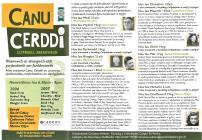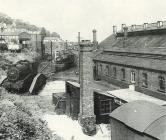Content can be downloaded for non-commercial purposes, such as for personal use or in educational resources.
For commercial purposes please contact the copyright holder directly.
Read more about the The Creative Archive Licence.
Description
Lede
The story of the Charterhouse Lifeboat, from its role in a famous rescue off Fishguard's Needle Rock to its conservation and role in the present.
Story
A cold dark night in December 1920 saw the most celebrated of the Fishguard’s many lifeboat rescues. The boat in question was Charterhouse, funded by the school of that name and presented to the RNLI station in 1908. The boat was built for rough weather with a multi-layered hull, buoyancy tanks fore and aft, and an open deck allowing water to run off. Charterhouse was the first motorised lifeboat in Wales, with a 50 gallon fuel tank allowing the engine to run for 18 hours.
On the night in question the three-masted Dutch motor schooner Hermina, en route to Rotterdam, had taken shelter in Fishguard Bay but with a heavy sea running in the north-west gale the anchors started to drag. The captain ordered flares to be fired and Charterhouse responded, putting out to sea under the command of 65-year-old coxswain John Howells.
The lifeboat anchored alongside the stricken vessel but getting a line aboard the Hermina proved challenging as the waves lifted Charterhouse as high as the schooner’s rigging. After an hour seven of the Hermina’s crew had been taken off but the captain, chief officer and second mate insisted on remaining aboard despite the imminent danger of the ship running on to Needle Rock, a jagged pinnacle jutting out of the water below sheer cliffs.
Charterhouse started back to shore but by now the engine was drenched and had cut out. The crew had no option but to rely on oars alone to make their way back across the turbulent waters with the seven rescued men. Worse was to come: the mizzen sail ripped in the wind and the mast fell into the sea. Two crew members managed to crawl across the bows to set the jib sail. By dint of exemplary courage and superlative seamanship Charterhouse was manoeuvred away from the cliffs and out into a position where she could re-enter the harbour, the whole endeavour taking over three hours.
No sooner had the lifeboat reached safety that flares went up from Hermina once again: she was breaking up on Needle Rock. One man was washed away and drowned but the other two were rescued by a local man, William Howells, who was lowered on a rope and managed to bring them up to the cliff top. (Remnants of the schooner are still visible below at the lowest tides.)
For this heroic rescue the coxswain was awarded a RNLI gold medal and rest of the crew silver and bronze. They all, along with Charterhouse herself as guest of honour, travelled to London by train to receive their awards from the Prince of Wales in person.
During her twenty-seven years’ service at Fishguard Charterhouse was launched on 20 rescue missions and saved 47 lives. In 1930 she replaced by the White Star lifeboat. But that is not the end of the story. In 2008 a local historian, Phil Davies, set out to trace Charterhouse and discovered she had been converted into a yacht, renamed Marian and had ended up in North Wales as the holiday houseboat of a family called Lomas. When tracked down, she was barely seaworthy and badly in need of attention. The Lomas family generously offered to donate her back to the community of Fishguard and Goodwick where a group of enthusiasts set to work on a long restoration job.
The work was led by the Charterhouse Trust in Fishguard. The original hope of the Trust was to exhibit the lifeboat in Goodwick. This turned out to be a difficult aim, as none of the buildings already on the seafront were available or suitable.
Things came to a head when the Charterhouse Trust was informed that the boat could no longer be kept at Fishguard port. It had been housed there since it was returned to Goodwick in 2008. There was only one place the Trust could think of to rehome Charterhouse: the West Wales Maritime Heritage Museum.
The Museum were more than happy to offer her a home and so she was moved there in January 2020, originally on loan. The Trust continued their work, fundraising to build a shelter to protect Charterhouse on land. In time, it was decided that the West Wales Maritime Heritage Museum was a very apt place for a permanent home for Charterhouse. In April 2021 Charterhouse was formally donated to the Museum and they are now its owners. There are no plans for it to be returned to Goodwick or to ever be moved again. Charterhouse has a permanent home now: the rescuer rescued.
Factoid:
- A copper pin from the Hermina was recovered and reported to the Receiver of Wrecks in 2008. The full character and extent of archaeological remains is presently unknown.
- Mr Emlyn Morgan passed away in April 2021 at the age of 106, the oldest man in Pembrokeshire. Mr Morgan was one of the crowd of people who ran to the cliffs above the wreck of the Hermina. His father then descended the cliffs, with the help of a rope, and rescued one of the stranded crew members.





Do you have information to add to this item? Please leave a comment
Comments (0)
You must be logged in to leave a comment